Chen Change Loy
MeViS: A Multi-Modal Dataset for Referring Motion Expression Video Segmentation
Dec 11, 2025Abstract:This paper proposes a large-scale multi-modal dataset for referring motion expression video segmentation, focusing on segmenting and tracking target objects in videos based on language description of objects' motions. Existing referring video segmentation datasets often focus on salient objects and use language expressions rich in static attributes, potentially allowing the target object to be identified in a single frame. Such datasets underemphasize the role of motion in both videos and languages. To explore the feasibility of using motion expressions and motion reasoning clues for pixel-level video understanding, we introduce MeViS, a dataset containing 33,072 human-annotated motion expressions in both text and audio, covering 8,171 objects in 2,006 videos of complex scenarios. We benchmark 15 existing methods across 4 tasks supported by MeViS, including 6 referring video object segmentation (RVOS) methods, 3 audio-guided video object segmentation (AVOS) methods, 2 referring multi-object tracking (RMOT) methods, and 4 video captioning methods for the newly introduced referring motion expression generation (RMEG) task. The results demonstrate weaknesses and limitations of existing methods in addressing motion expression-guided video understanding. We further analyze the challenges and propose an approach LMPM++ for RVOS/AVOS/RMOT that achieves new state-of-the-art results. Our dataset provides a platform that facilitates the development of motion expression-guided video understanding algorithms in complex video scenes. The proposed MeViS dataset and the method's source code are publicly available at https://henghuiding.com/MeViS/
* IEEE TPAMI, Project Page: https://henghuiding.com/MeViS/
Generative Photographic Control for Scene-Consistent Video Cinematic Editing
Nov 17, 2025Abstract:Cinematic storytelling is profoundly shaped by the artful manipulation of photographic elements such as depth of field and exposure. These effects are crucial in conveying mood and creating aesthetic appeal. However, controlling these effects in generative video models remains highly challenging, as most existing methods are restricted to camera motion control. In this paper, we propose CineCtrl, the first video cinematic editing framework that provides fine control over professional camera parameters (e.g., bokeh, shutter speed). We introduce a decoupled cross-attention mechanism to disentangle camera motion from photographic inputs, allowing fine-grained, independent control without compromising scene consistency. To overcome the shortage of training data, we develop a comprehensive data generation strategy that leverages simulated photographic effects with a dedicated real-world collection pipeline, enabling the construction of a large-scale dataset for robust model training. Extensive experiments demonstrate that our model generates high-fidelity videos with precisely controlled, user-specified photographic camera effects.
DHAGrasp: Synthesizing Affordance-Aware Dual-Hand Grasps with Text Instructions
Sep 26, 2025Abstract:Learning to generate dual-hand grasps that respect object semantics is essential for robust hand-object interaction but remains largely underexplored due to dataset scarcity. Existing grasp datasets predominantly focus on single-hand interactions and contain only limited semantic part annotations. To address these challenges, we introduce a pipeline, SymOpt, that constructs a large-scale dual-hand grasp dataset by leveraging existing single-hand datasets and exploiting object and hand symmetries. Building on this, we propose a text-guided dual-hand grasp generator, DHAGrasp, that synthesizes Dual-Hand Affordance-aware Grasps for unseen objects. Our approach incorporates a novel dual-hand affordance representation and follows a two-stage design, which enables effective learning from a small set of segmented training objects while scaling to a much larger pool of unsegmented data. Extensive experiments demonstrate that our method produces diverse and semantically consistent grasps, outperforming strong baselines in both grasp quality and generalization to unseen objects. The project page is at https://quanzhou-li.github.io/DHAGrasp/.
MARS2 2025 Challenge on Multimodal Reasoning: Datasets, Methods, Results, Discussion, and Outlook
Sep 17, 2025
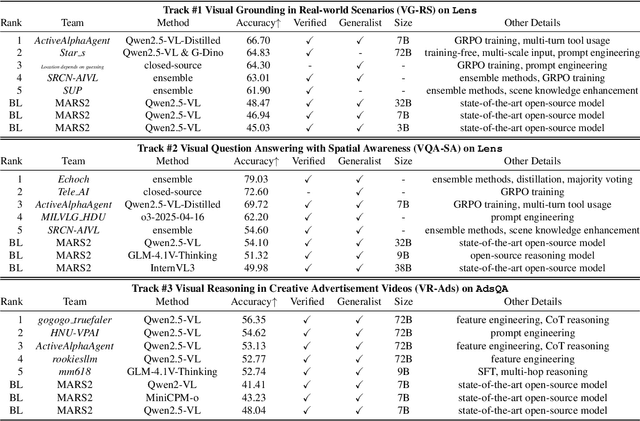

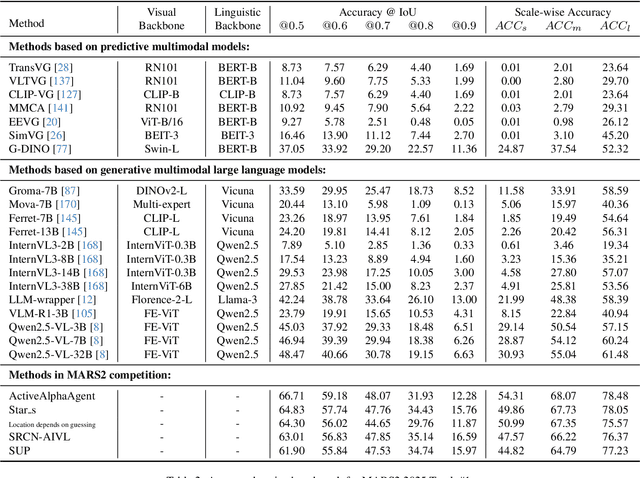
Abstract:This paper reviews the MARS2 2025 Challenge on Multimodal Reasoning. We aim to bring together different approaches in multimodal machine learning and LLMs via a large benchmark. We hope it better allows researchers to follow the state-of-the-art in this very dynamic area. Meanwhile, a growing number of testbeds have boosted the evolution of general-purpose large language models. Thus, this year's MARS2 focuses on real-world and specialized scenarios to broaden the multimodal reasoning applications of MLLMs. Our organizing team released two tailored datasets Lens and AdsQA as test sets, which support general reasoning in 12 daily scenarios and domain-specific reasoning in advertisement videos, respectively. We evaluated 40+ baselines that include both generalist MLLMs and task-specific models, and opened up three competition tracks, i.e., Visual Grounding in Real-world Scenarios (VG-RS), Visual Question Answering with Spatial Awareness (VQA-SA), and Visual Reasoning in Creative Advertisement Videos (VR-Ads). Finally, 76 teams from the renowned academic and industrial institutions have registered and 40+ valid submissions (out of 1200+) have been included in our ranking lists. Our datasets, code sets (40+ baselines and 15+ participants' methods), and rankings are publicly available on the MARS2 workshop website and our GitHub organization page https://github.com/mars2workshop/, where our updates and announcements of upcoming events will be continuously provided.
STream3R: Scalable Sequential 3D Reconstruction with Causal Transformer
Aug 14, 2025Abstract:We present STream3R, a novel approach to 3D reconstruction that reformulates pointmap prediction as a decoder-only Transformer problem. Existing state-of-the-art methods for multi-view reconstruction either depend on expensive global optimization or rely on simplistic memory mechanisms that scale poorly with sequence length. In contrast, STream3R introduces an streaming framework that processes image sequences efficiently using causal attention, inspired by advances in modern language modeling. By learning geometric priors from large-scale 3D datasets, STream3R generalizes well to diverse and challenging scenarios, including dynamic scenes where traditional methods often fail. Extensive experiments show that our method consistently outperforms prior work across both static and dynamic scene benchmarks. Moreover, STream3R is inherently compatible with LLM-style training infrastructure, enabling efficient large-scale pretraining and fine-tuning for various downstream 3D tasks. Our results underscore the potential of causal Transformer models for online 3D perception, paving the way for real-time 3D understanding in streaming environments. More details can be found in our project page: https://nirvanalan.github.io/projects/stream3r.
Enhanced Generative Structure Prior for Chinese Text Image Super-resolution
Aug 11, 2025Abstract:Faithful text image super-resolution (SR) is challenging because each character has a unique structure and usually exhibits diverse font styles and layouts. While existing methods primarily focus on English text, less attention has been paid to more complex scripts like Chinese. In this paper, we introduce a high-quality text image SR framework designed to restore the precise strokes of low-resolution (LR) Chinese characters. Unlike methods that rely on character recognition priors to regularize the SR task, we propose a novel structure prior that offers structure-level guidance to enhance visual quality. Our framework incorporates this structure prior within a StyleGAN model, leveraging its generative capabilities for restoration. To maintain the integrity of character structures while accommodating various font styles and layouts, we implement a codebook-based mechanism that restricts the generative space of StyleGAN. Each code in the codebook represents the structure of a specific character, while the vector $w$ in StyleGAN controls the character's style, including typeface, orientation, and location. Through the collaborative interaction between the codebook and style, we generate a high-resolution structure prior that aligns with LR characters both spatially and structurally. Experiments demonstrate that this structure prior provides robust, character-specific guidance, enabling the accurate restoration of clear strokes in degraded characters, even for real-world LR Chinese text with irregular layouts. Our code and pre-trained models will be available at https://github.com/csxmli2016/MARCONetPlusPlus
Half-Physics: Enabling Kinematic 3D Human Model with Physical Interactions
Jul 31, 2025Abstract:While current general-purpose 3D human models (e.g., SMPL-X) efficiently represent accurate human shape and pose, they lacks the ability to physically interact with the environment due to the kinematic nature. As a result, kinematic-based interaction models often suffer from issues such as interpenetration and unrealistic object dynamics. To address this limitation, we introduce a novel approach that embeds SMPL-X into a tangible entity capable of dynamic physical interactions with its surroundings. Specifically, we propose a "half-physics" mechanism that transforms 3D kinematic motion into a physics simulation. Our approach maintains kinematic control over inherent SMPL-X poses while ensuring physically plausible interactions with scenes and objects, effectively eliminating penetration and unrealistic object dynamics. Unlike reinforcement learning-based methods, which demand extensive and complex training, our half-physics method is learning-free and generalizes to any body shape and motion; meanwhile, it operates in real time. Moreover, it preserves the fidelity of the original kinematic motion while seamlessly integrating physical interactions
SA-LUT: Spatial Adaptive 4D Look-Up Table for Photorealistic Style Transfer
Jun 16, 2025Abstract:Photorealistic style transfer (PST) enables real-world color grading by adapting reference image colors while preserving content structure. Existing methods mainly follow either approaches: generation-based methods that prioritize stylistic fidelity at the cost of content integrity and efficiency, or global color transformation methods such as LUT, which preserve structure but lack local adaptability. To bridge this gap, we propose Spatial Adaptive 4D Look-Up Table (SA-LUT), combining LUT efficiency with neural network adaptability. SA-LUT features: (1) a Style-guided 4D LUT Generator that extracts multi-scale features from the style image to predict a 4D LUT, and (2) a Context Generator using content-style cross-attention to produce a context map. This context map enables spatially-adaptive adjustments, allowing our 4D LUT to apply precise color transformations while preserving structural integrity. To establish a rigorous evaluation framework for photorealistic style transfer, we introduce PST50, the first benchmark specifically designed for PST assessment. Experiments demonstrate that SA-LUT substantially outperforms state-of-the-art methods, achieving a 66.7% reduction in LPIPS score compared to 3D LUT approaches, while maintaining real-time performance at 16 FPS for video stylization. Our code and benchmark are available at https://github.com/Ry3nG/SA-LUT
SeedVR2: One-Step Video Restoration via Diffusion Adversarial Post-Training
Jun 05, 2025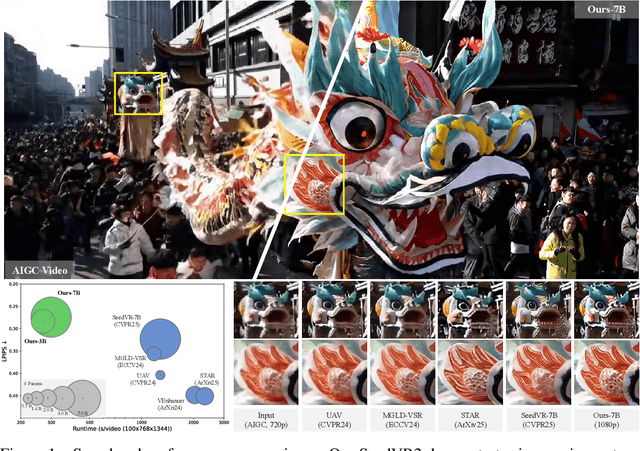
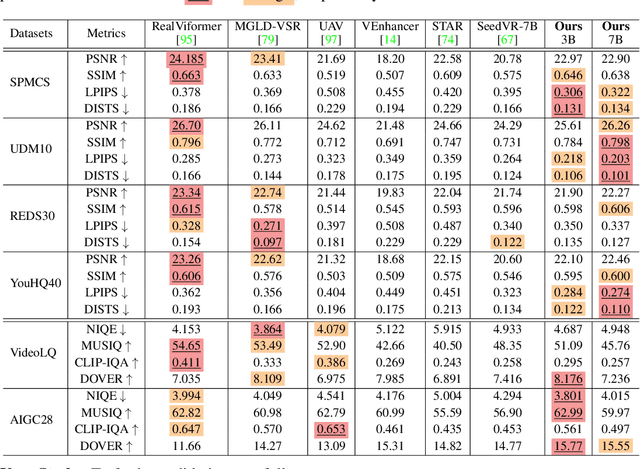
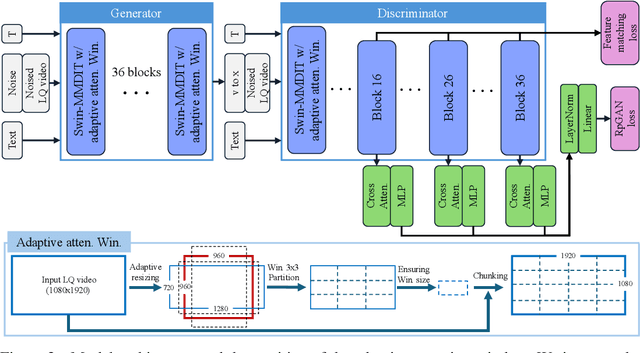
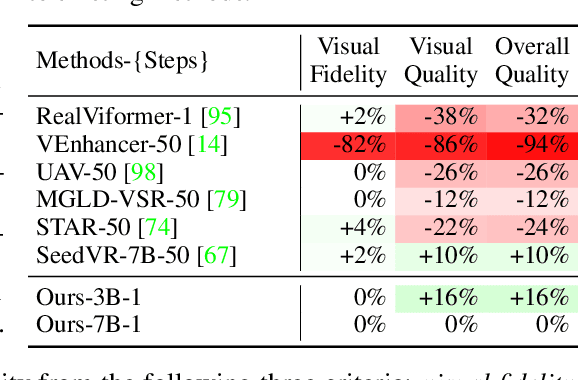
Abstract:Recent advances in diffusion-based video restoration (VR) demonstrate significant improvement in visual quality, yet yield a prohibitive computational cost during inference. While several distillation-based approaches have exhibited the potential of one-step image restoration, extending existing approaches to VR remains challenging and underexplored, particularly when dealing with high-resolution video in real-world settings. In this work, we propose a one-step diffusion-based VR model, termed as SeedVR2, which performs adversarial VR training against real data. To handle the challenging high-resolution VR within a single step, we introduce several enhancements to both model architecture and training procedures. Specifically, an adaptive window attention mechanism is proposed, where the window size is dynamically adjusted to fit the output resolutions, avoiding window inconsistency observed under high-resolution VR using window attention with a predefined window size. To stabilize and improve the adversarial post-training towards VR, we further verify the effectiveness of a series of losses, including a proposed feature matching loss without significantly sacrificing training efficiency. Extensive experiments show that SeedVR2 can achieve comparable or even better performance compared with existing VR approaches in a single step.
OpenUni: A Simple Baseline for Unified Multimodal Understanding and Generation
May 29, 2025Abstract:In this report, we present OpenUni, a simple, lightweight, and fully open-source baseline for unifying multimodal understanding and generation. Inspired by prevailing practices in unified model learning, we adopt an efficient training strategy that minimizes the training complexity and overhead by bridging the off-the-shelf multimodal large language models (LLMs) and diffusion models through a set of learnable queries and a light-weight transformer-based connector. With a minimalist choice of architecture, we demonstrate that OpenUni can: 1) generate high-quality and instruction-aligned images, and 2) achieve exceptional performance on standard benchmarks such as GenEval, DPG- Bench, and WISE, with only 1.1B and 3.1B activated parameters. To support open research and community advancement, we release all model weights, training code, and our curated training datasets (including 23M image-text pairs) at https://github.com/wusize/OpenUni.
 Add to Chrome
Add to Chrome Add to Firefox
Add to Firefox Add to Edge
Add to Edge